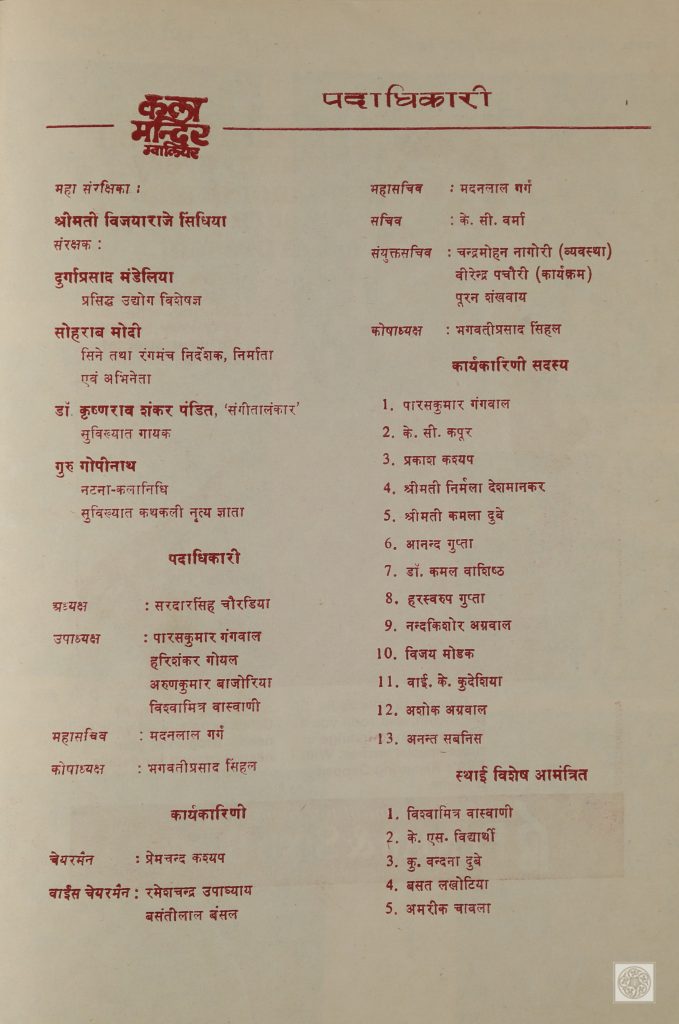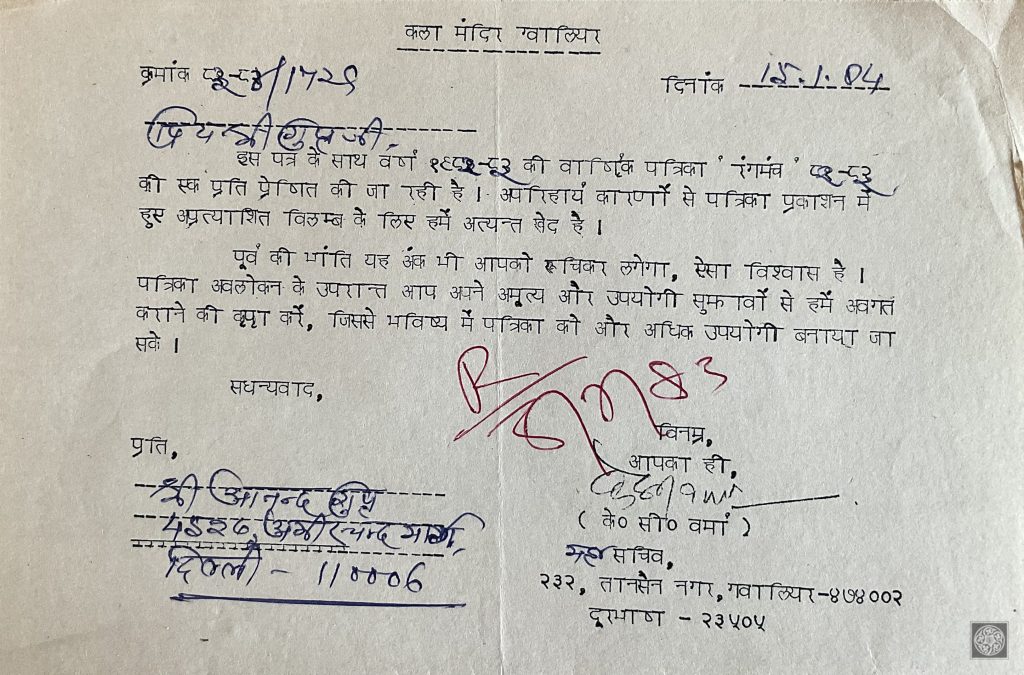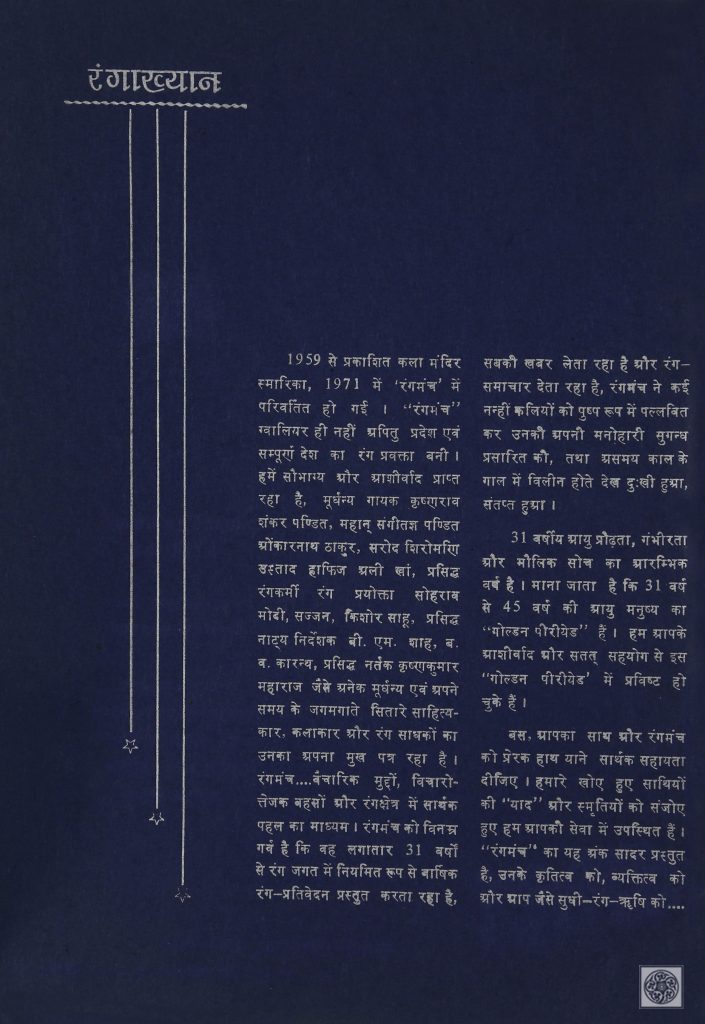Rangmanch: Analyzing the Finances, Circuits and Discourse Generated by the Journal (1976-1990) Published by Kala Mandir, Gwalior
Theatre periodicals offer an insight into the networks between organizations, groups, funding agencies and sponsors through the publication of organization’s annual reports and advertising patrons, as well as their reports on theatre productions at festivals organized by various agencies. Such networks enable us to critically analyse the ways in which patronage, along with its interconnectedness to various nodes in the theatre circuit, regulates the production of theatre, its narrative, reportage and research, generating peculiar discourses on theatre according to its geo-political location. The twentieth century witnessed not only a boom in the reinvention of theatres in India and in the publication of theatre magazines and journals, but also the rapid discontinuation of the periodicals within a few years of publication. It was predominantly regional language periodicals that closed down early. Reasons behind these discontinuations ranged from lack of contributors for the ephemera to the dearth of subscriptions, advertisements, and thus, funds. Most publications and their editors/founders like Anand Gupt (Abhinay), Inder Lal Dass (Theatre News/ Stagedoor), seeded in personal funds or were heavily dependent on subscriptions to keep these periodicals in the press and running. However, one can find certain organizations who were not only able to sustain the publication of the periodical over a long period of time, but also incurred profits from the publication. One such journal was Rangmanch, published by a Madhya Pradesh based theatre organization called Kala Mandir Gwalior.
Slide-1
Cover images of the journal Rangmanch from 1976 to 1990 published by Kala Mandir Gwalior from Madhya Pradesh
Kala Mandir Gwalior was established in the year 1954. The main objectives of the organization were to promote and develop cultural practices in Madhya Pradesh. With trustees like Smt. Vijayaraje Scindia (Maharani of Gwalior, Co-founder of Bharatiya Janata Party), Sohrab Modi (Theatre & Film Director, Producer and Actor), Dr Krushnarao Shankar Pandit (Classical Singer), Guru Gopinath (Kathakali Actor-Dancer), Durgaprasad Mandelia (Industry Specialist) and Seth Balchand Pamnani (J.B. Mangharam & Company Pvt. Ltd.), Kala Mandir Gwalior received grants in aid from Madhya Pradesh Kala Parishad, Bhopal, Sangeet Natak Academy, New Delhi, Municipal Corporation, Gwalior, J.C. Mills, to name a few. The group was also a participant in the Nehru Shatabdi Natya Samaroh of 1989 with Adya Rangacharya’s play, Suno Janmeya translated from Kannada to Hindi and directed by B. M. Shah. Adapting ‘folk’ forms like Nautanki and reinventing the modern urban theatre form, the group staged Kanchan-Rang (1975-76), Tughlak (1975-76), Dularibai (1980-81), Santola (1980-81), Arey Sharif Log (1989), Thank You My Lord (1988), to name a few. The organization published a Hindi language souvenir journal called ‘Kala Mandir Smarika’ from 1959, which was then renamed Rangmanch in the year 1971. The Anand Gupt Collection at the Alkazi Theatre Archives houses seven issues of Rangmanch from the year 1976 to 1990 edited by K. C. Verma.

A page from 1980-81 issue of Rangmanch informing the readers about the office-bearers of Kala Mandir Gwalior
The 1975-76 issue of Rangmanch, an annual journal, reports that the funds acquired from the publication of the periodical were the main source of income for the theatre organization. That year, the periodical saved Rs. 5000/- mainly generated from advertisements. It received advertisements from cloth mills based in Madhya Pradesh, Bombay, New Delhi, with J. C. Mills being an annual donor to the organization, local business of incense sticks and clothing stores as well as from banks like State Bank of India and Bank of Maharashtra. The journal was available to anyone with a membership with the organization. Later on, towards the end of the 1980s, the journal began to print bilingual material, with some articles printed in English, while others in Hindi.
Slide-2 New
Annual report of Kala Mandir Gwalior in in the 1975-76 issue of Rangmanch
Slide-3
Articles in Hindi and English in the 1989-90 issue of Rangmanch
Being an annual publication and thus, saving enough funds each month as compared to a monthly or quarterly, Rangmanch was able to experiment with its design in terms of the size and colour of its pages, included illustrations, a dedicated section to photographs of productions from the past year, a full drama script, and reports on theatre festivals in Delhi and Madhya Pradesh and its neighbouring states of Uttar Pradesh, Bihar, Chhattisgarh, Jharkhand and Maharashtra. Eliminating the subscription feature to the magazine and introducing membership to the organization itself, Rangmanch was able to network with theatre-makers and patrons in a unique manner. The 1982-83 issue of Rangmanch published a list of 130 members of the organization hailing from various professions like advocates, managers, industrialists, theatremakers, bankers, teachers, government employees, professors, and businessmen from Gwalior. As a souvenir, this annual periodical was also mailed to influential theatre personalities as well as journalists who could then contribute to the journal. This becomes evident from the typed letter sent to Anand Gupt in 1984, urging him to examine the 1982-83 issue of the journal and contribute to the forthcoming issues.

Typed letter from the editor of Rangmanch, K. C. Verma to Anand Gupt on January 15, 1984
Unlike other contemporary regional journals, Rangmanch, due to its annual periodicity was able to include photographs not only of productions that took place in the past year, but also of the authors at the beginning of the articles. The journal also featured an increased number of women authors. The journal also published self-ethnographic accounts of practitioners from varied performing arts, as well as of women authors, thus documenting their encounters with art and their journey as an artist or an author. Such biographical articles also helped theorize the art form through the lens of the practitioner. According to the foreword to the 1989-90 issue of Rangmanch, the journal had become the main speaker of the theatre of the region and the nation and served as the mouthpiece for writers, artists and theatre-makers like B.V. Karanth, B. M. Shah, Ustad Hafiz Ali Khan, Sohrab Modi, Krushnarao Shankar Pandit, Pandit Onkarnath Thakur, Sajjan, Kishore Sahu, Krushnakumar Maharaj, etc.
Slide 5 New
Articles by women authors in Rangmanch
‘A Dancing Myth Exploded’ by Yamini Krishnamurthy (Issue 1979-80, Rangmanch)
‘Natya Shodh Sansthan: Vartaman Evam Bhavishya’ by Pratibha Agrawal (Issue1982-83, Rangmanch)

Foreword to the 1989-90 issue of Rangmanch
Encompassing a bird’s eye view of the theatre scene in and around Madhya Pradesh, while informing the member-readers about the new theatre developments from across the country, Kala Mandir Gwalior in association with Madhya Pradesh Kala Parishad was focusing on the development of Hindi theatre. It also educated its reader about theatre practice through didactic articles via Rangmanch. With writers like Nemichandra Jain, K. T. Deshmukh, Nalini Malhotra, Yamini Krishnamurthy, Anand Gupt, Pratibha Agrawal, to name a few, sending in their articles for publication from across the country, the theatre circuit and networking of Kala Mandir Gwalior can be gauged through its annual journal Rangmanch.
Slide-6
Theatre news reportage from Kolkata, Gwalior and Pakistan in Issue 1976-77 and Issue 1980-81 of Rangmanch
The 1976-77 issue of Rangmanch reports the performance of Brecht’s Mother Courage and Her Children by Performance Group, New York, at Ravindra Natya Gruha in Madhya Pradesh. Introducing its readers to Richard Schechner and his practice of ‘environmental theatre’, the article highlights the role of Madhya Pradesh Kala Parishad in bringing the production to India. Apart from reportage on such collaborative happenings, the journal also reported and at the same time, critically examined the nature of theatre festivals like Kalidas Samaroh, Akhil Bharatiya Natya Mahotsav, Bahubhashi Natya Mahotsav, to name a few.
Slide-7
Reportage of the ‘Mother Courage’ production by Richard Schechner at the Madhya Pradesh Kala Parishad, Bhopal in 1976-77 issue of Rangmanch
Other articles mainly focused on the sustainability of Hindi theatre and reviewed, reported as well as discussed new works that emerged in the Hindi theatre movement. Conceptual, as well as practical issues relating to theatre, were discussed in the journal – from the aesthetics of translations and adaptations in Hindi to the operational issues faced by small-town theatre groups and the influence of local politicians on theatre activities.
The issue of Rashtra bhasha i.e. the national language of India was/is a burning topic in politics and culture likewise. During the 1950s, only 45% of the Indian population could speak Hindi. Hindi, having its roots in Sanskrit and written in the Devanagari script, was contested to be more ‘Indian’ than Hindustani, which evolved from Persian as well as Sanskrit. This language conflict is still prevalent in India and its debates can be highlighted in the Hindi theatre movement. Starting from Bhartendu Harishchandra and his plays, the Hindi theatre movement was in full swing from the second half of the 19th century. With the advent of the Theatre of the Roots movement, experimentation with regional aesthetics and language took prominence. Although the Hindi language gave to the theatre world playwrights and directors like Habib Tanvir, the articles in Rangmanch magazine point towards a dearth in Hindi theatre playwriting, criticizing the bookish unstageable plays in Hindi and at the same time criticizing the extensive translations of English, Marathi, Bengali, Kannada plays in Hindi.
In the 1976-77 issue of Rangmanch, Shriram Tiwari interviews Brajmohan Shah (actor, directors, NSD graduate) on his views about the Hindi theatre movement and the kind of plays that should be staged. B. M. Shah replies, “ सही नाटक वही है… हम से हमारी पहचान कराए। हमारी स्थितियों के बाबत सोचने को विवश करदे। इसके लिए हम एक सीमा तक अनूदित नाटकों का सहारा भी ले सकते हैं। जो कुछ लोग बाहरी नाटकों के खेलने के बाबत टोकते हैं, उनसे पूछना केवल यह है कि जब साहित्य की दूसरी विधाओं में अनुभव आदि के लिए रोकटोक नही हैं, तो नाटक में ही क्यों? और उस हालत में तो और भी गैर मुनासिब हो जाता है टोकना, जब इसके बावजूद हिंदी में भी स्तरीय नाटक लिखे और खेले जा रहे हैं। तब भी ऐसी बात करनेवाले लोगों का (जो अच्छे नाटकों के अनुवाद के खिलाफ है) दोगलापन साफ जाहिर हो जाता है क्योंकि न तो ये लोग नाटक के प्रति जिम्मेदार हैं और न अपने पाठकों के प्रति। कहने का मतलब यह है कि जो नाटक एक पूरी दुनियां से हमें रूबरू करवाता है चाहे वह किसी भी भाषा का हो, हिंदी रंगमंच पर खेला जाना चाहिए।”
All Courtesy: Anand Gupt Collection/ Alkazi Theatre Archives
